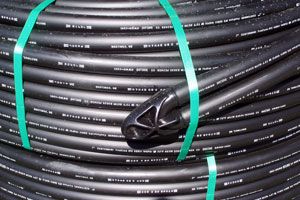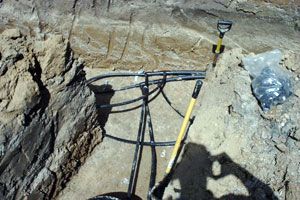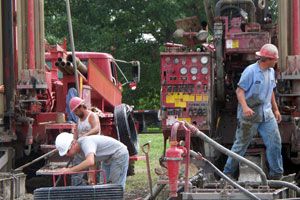Vertical Loop Installation
Homes where enough land is not available and large commercial buildings like schools often use vertical loop systems over horizontal loop systems. Vertical loops allow for the largest loop on the smallest area. Vertical loops require less piping than horizontal because the Earth's ambient temperature is more stable farther below the surface. An average home can be accommodated by a vertical loop occupying a space as small as 20'x20.'

Vertical loops enjoy day 1 optimal performance while horizontal loops require time for excavated dirt to settle back to 100% compaction. Proper tremie grouting of vertical bores ensures instant contact between the loop and the ground.

Vertical closed loop systems involve a series of 100' to 500' deep holes drilled about 10' to 20' feet apart. The holes are typically 4" to 6" in diameter. Most residential applications in our service area use ¾" and 1"HDPE loops and are drilled to depths of 150' to 300.' Commercial loops can often be as large as 1 1/4" pipe in 500' holes. The building heating and cooling loads and the area geology will determine the number and depth of the holes. Different soil and rock formations can affect drilling costs and should be factored when considering a vertical loop. Thermal conductivity testing is recommended on larger projects.

The loop pipes installed into the hole are joined at the bottom with a factory u-bend fitting and manifolded together in bucket dug trenches usually 4' below grade. The series of interconnected loops is then run into the building as supply and return headers.
The drawback to this type of loop is the fact that they are typically the most expensive to install due to the high cost of drilling machines and expertise required for proper installation. The drilling rigs necessary to reach depths needed for loop installation are very heavy.
When possible, drilling operations should take place on undisturbed land. Overhead clearance of nearly 40' must be allowed to accommodate the drill's working height.

A large quantity of water is needed to complete the drilling process.
State codes and required setback distances from potential sources of contamination to ground water resources must also be followed.